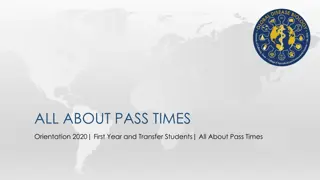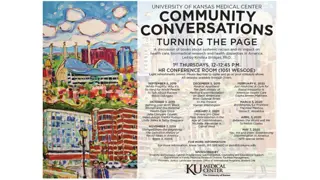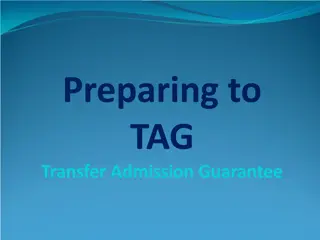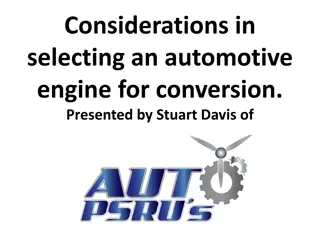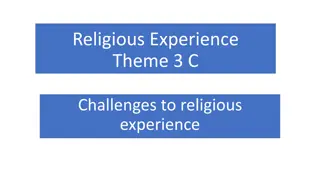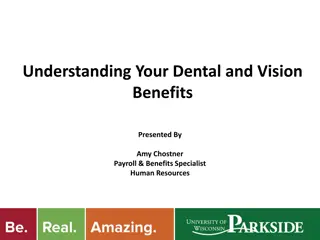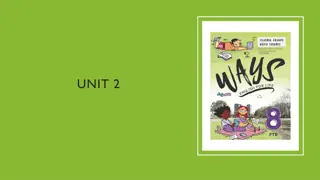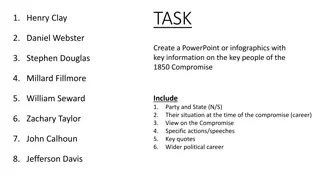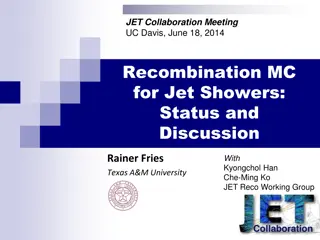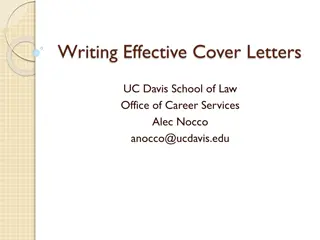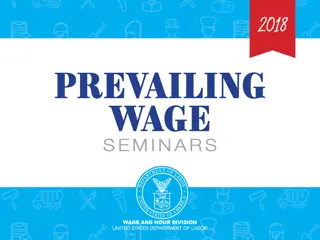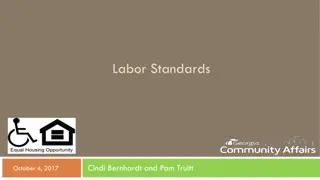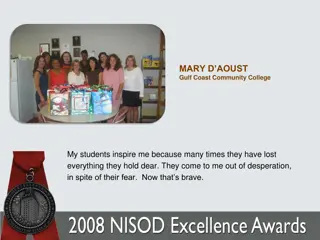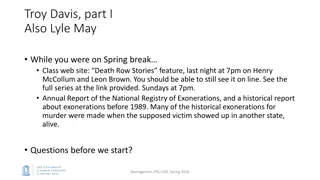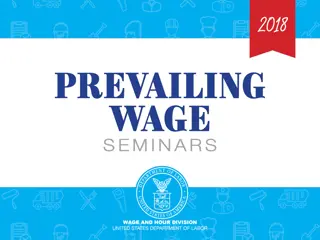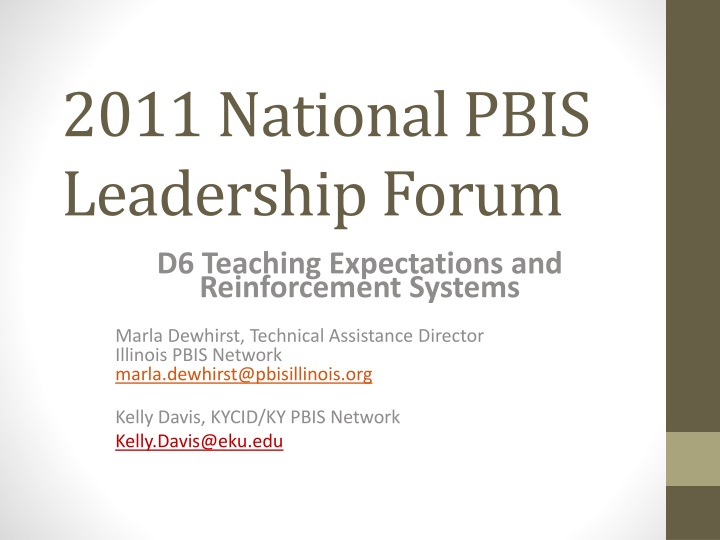
Teaching Behavior Expectations and Strategies for Positive School Culture
Discover insights and strategies from the 2011 National PBIS Leadership Forum on teaching behavior expectations effectively. Learn the importance of instructional techniques, feedback, and reinforcement systems in promoting positive behavior among students. Explore the role of a behavioral curriculum, school-wide expectations, and addressing behavioral errors to foster a safe and respectful learning environment.
Download Presentation

Please find below an Image/Link to download the presentation.
The content on the website is provided AS IS for your information and personal use only. It may not be sold, licensed, or shared on other websites without obtaining consent from the author. If you encounter any issues during the download, it is possible that the publisher has removed the file from their server.
You are allowed to download the files provided on this website for personal or commercial use, subject to the condition that they are used lawfully. All files are the property of their respective owners.
The content on the website is provided AS IS for your information and personal use only. It may not be sold, licensed, or shared on other websites without obtaining consent from the author.
E N D
Presentation Transcript
2011 National PBIS Leadership Forum D6 Teaching Expectations and Reinforcement Systems Marla Dewhirst, Technical Assistance Director Illinois PBIS Network marla.dewhirst@pbisillinois.org Kelly Davis, KYCID/KY PBIS Network Kelly.Davis@eku.edu
Students learn appropriate behavior in the same way a child who doesn t know how to read learns to read through instruction, practice, feedback, and encouragement.
Research Findings Teaching behavior expectations, having a reward system, and monitoring must occur if implementation fidelity and sustainability are to be achieved Administrative support, communication, and data-based decision-making were found to be the most important characteristics for long- term sustainability Doolittle, 2006
Lesson Plan Items A behavioral curriculum includes teaching expectations and procedures/rules Lessons include examples and non-examples Lessons use a variety of teaching strategies Lessons are embedded into subject area curriculum Faculty/staff and students are involved in development and delivery of behavioral curriculum Strategies to share key features of PBIS program with families/community are developed and implemented BOQ
My Schools Expectations 1. Be Safe 2. Be Responsible 3. Be Respectful Once you have developed school-wide expectations, it is not enough to just post the words on the walls of the classroom YOU MUST TEACH THEM!
Behavioral Errors Typically occur because: Students do not have appropriate skills (i.e., skill deficits) oStudents do not know when to use skills oStudents are not taught what they need to know oSkills are not taught in context
If a child doesnt know how to read, we teach. If a child doesn t know how to swim, we teach. If a child doesn t know how to multiply, we teach. If a child doesn t know how to drive, we teach. If a child doesn t know how to behave, we teach? punish? Why can t we finish the last sentence as automatically as we do the others? *Discuss for 3 minutes with your shoulder partner Herner, 1998
Research on Teaching Behavior Expectations and Procedures Decreases in problem behavior were found in non-classroom areas where there was: oActive teaching of expected behaviors oActive supervision oUse of pre-correction for prevention oHigh rates of positive reinforcement Lewis, Colvin, & Sugai, 2000; Lewis & Garrison-Harrell, 1999; Lewis, Powers, Kelk, & Newcomer, 2002; Lewis, Sugai, & Colvin, 1998
Why Develop a System for Teaching Behavior? Behaviors are prerequisites for academics Procedures and routines create structure Repetition is key to learning new skills: oFor a child to learn something new, it needs to be repeated on average 8 times oFor a child to unlearn an old behavior and replace it with a new behavior, the new behavior must be repeated on average 28 times (Harry Wong)
Specially Designed Lesson Plans Provide initial lesson plans and/or lesson plan format for teachers to begin teaching behavior Build on what you have (e.g., character education) Develop a system for expanding behavior lesson plan ideas throughout the year Determine the minimum requirements for teaching behavior (i.e. how often)
Strategies for Success Describe specific, observable behaviors for each expectation Plan to model the desired behaviors Provide students with written and graphic cues in the setting where the behaviors are expected Acknowledge efforts Plan to re-teach and restructure teaching Allow students to participate in the development process Use teachable moments that arise in core subject areas and in non-academic times
Video Examples What specific skill(s) was being taught? What were the specific behaviors taught? How were those behaviors prompted? How were those behaviors acknowledged? How were the behaviors linked to school- wide expectations?
The quickest way to change behavior.in anyone. Research indicates that you can improve behavior by 80% just by pointing out what someone is doing correctly. Point out what
What is School-Wide Reinforcement and Acknowledgement? Definition: A system that provides immediate, intermittent, and long-term reinforcements, given by adults in the building, to any students displaying desired school-wide expectations, behaviors, or associated rules
Are Rewards Dangerous? our research team has conducted a series of reviews and analysis of (the reward) literature; our conclusion is that there is no inherent negative property of reward. Our analyses indicate that the argument against the use of rewards is an overgeneralization based on a narrow set of circumstances. *What types of barriers do you see with staff in regards to using school-wide rewards? Cameron, 2002, Cameron & Pierce, 1994; 2002; Cameron, Banko, & Pierce, 2001
Why Develop a School-wide Acknowledgment System? Increases the likelihood that desired behaviors will be repeated Focuses staff and student attention on desired behaviors Fosters a positive school climate Reduces the need for engaging in time consuming disciplinary measures
Reward/Recognition Items from the Benchmarks of Quality A system of rewards has elements that are implemented consistently across campus A variety of methods are used to reward students Rewards are linked to expectations and rules Rewards are varied to maintain student interest Ratios of acknowledgement to corrections are high Students are involved in identifying/developing incentives The system includes incentives for staff/faculty BOQ
Why Do We Acknowledge Desired Behavior? Reinforce the teaching of new behaviors Behavior is likely to become a habit and recur in the future only if demonstrating it has been beneficial Harness the influence of kids who are showing expected behaviors to encourage the kids who are not Strengthen positive behaviors that can compete with problem behavior Improve school climate Create positive interactions and rapport with students
Research on Reinforcement Systems High implementing PBIS schools were found to use a variety of individual and group rewards and to inform parents of appropriate student behavior while low implementing schools were found to use schoolwide reinforcement either inconsistently or not at all. Sparks, 2007
5:1 Gets the job done!!!
Rationale-What Does 5 Positives to 1 Negative Mean? Students should experience predominately positive interactions (ratio of 5 positives for every negative) on all locations of school. Positive Interactions= Behaviorally specific feedback as to what the student did right (contingent) Smile, nod, wink, greeting, attention, hand shake, high five (non-contingent) Negative Interactions= Non-specific behavioral corrections Ignoring student behavior (appropriate or inappropriate)
How Does 5 to 1 Happen? All Staff are expected to: Interact in a friendly, supportive manner at all times--- students, parents, guests and colleagues Initiate positive interactions by: Making eye contact Smiling nodding, winking Welcoming Offering a greeting Asking if assistance is required Provide positive feedback regarding appropriate student behavior Maintain an attitude of respect and support, even when correcting student behavior
5 : 1 Ratio, Its not Just for Kids Business Teams: High Performance = 5.6 positives to 1negative Medium Performance = 1.9 positives to 1 negative Low Performance = 1 positive to 2.7 negatives Losada, 1999; Losada & Heaphy, 2004 Successful Marriages: 5.1 positives to 1 negative (speech acts) and 4.7 positives to 1 negative (observed emotions) Gottoman, 1994
Activity: add to the list with your shoulder partner What acts as a positive reinforcer for you? Get out early? Finishing a task ? Lower # on the scale after a week of dieting? No panic attack when a police officer is along side the road . What acts as a negative reinforcer for your behavior? The beeping Put on seat belt to avoid the beeping? Making additional trips Writing things on a list to avoid forgetting?
Ratio of Interactions Teachers should interact with students 5 times more often when they are behaving appropriately than when they are behaving inappropriately (5:1 ratio) Interactions with students are considered positive or negative based on the behavior in which the student is engaged at the time attention is given Negative interactions are not wrong and are sometimes necessary; the key is the ratio Positive interactions can be provided in a variety of ways: verbal praise, nonverbal acknowledgement, non-contingent attention
Research on Ratio of Interactions After withdrawing praise from a classroom, off-task behavior increased from 8.7% to 25.5% When the rate of criticism was increased, off-task behavior increased from 25.5% to 31.2% with over 50% off-task behavior on some days (Becker, Engleman, & Thomas, 1975) In classes where teachers provided less than 65% positive statements, the percentage of students reporting that they like school decreased over the course of the school year In classes where teachers provided more than 70% positive statements, students reporting that they like school remained high across the school year (Oregon study)
Activity: Discuss Ways to Measure your Ratio Measure in short increments of time. Compare like situations and like times Collect pre and post are you doing better? Pennies to paperclips Index Card Tearing Hash marks on tape on your arm or pant leg Popsicle Sticks move them from one jar to the other for individuals you have given a positive
Non-contingent Attention Provides time and attention that is not tied to performance Fulfills the need to be noticed and valued Benefits Student teacher rapport Positive role-model for social interaction Improved climate overall Greeting, show interest, invite questions, interest conversations, provides opportunity to relate to all students even those with challenging behavior
Components of Acknowledgement Plans Immediate/High frequency/Predictable/Tangible Delivered at a high rate for a short period while teaching new behaviors or responding to problem behavior Name behavior and tie back to school-wide expectation upon delivery Examples: Caught Being Good , Lincoln Loot , Titan Bucks , positive referrals, points for privilege levels turned in for tangible/non- tangible prize Intermittent/Unexpected Bring surprise attention to certain behaviors or at scheduled intervals Used to maintain a taught behavior Examples: Raffles, special privileges, principal random call Long-term Celebrations Used to celebrate/acknowledge accomplishment ALL kids, all adults Examples: Quarterly activities: popcorn party, class movie, class field day
PBIS School-wide Acknowledgement Matrix (Students and Adults!) TYPE WHAT WHEN WHERE WHO High frequency for a short time when first teaching desired behavior or re-teaching identified problem behavior from data ALL STUDENTS, ALL ADULTS Immediate/High Frequency In the moment, predictable (e.g., Gotchas, Paws, High Fives) STUDENTS: ADULTS: Redemption of high frequency (e.g., school store, drawings) At least monthly ALL STUDENTS, ALL ADULTS STUDENTS: ADULTS: 31 Intermittent/Unpredictable (e.g., surprise homework completion treat, random use of gotchas in hallway) Maintaining a taught behavior (fading) ALL STUDENTS, ALL ADULTS STUDENTS: ADULTS: At least quarterly ALL STUDENTS, ALL ADULTS Long-term School-wide Celebrations (school-wide not individually based) FOR: Ex: ODR reduction, school-wide target met for certain setting/behavior area ACTIVITY: (e.g., ice cream social, dance, game day) BOTH TOGETHER:
Guidelines for Use of Acknowledgements Reinforcements are for every student in the classroom, regardless of where they fall in the PBIS triangle. Over time, move from: other-delivered to self-delivered (extrinsic vs. intrinsic motivation) Highly frequent to less frequent Predictable to unpredictable Tangible to social Adapt to data analysis feedback: boosters
Acknowledgement of Appropriate Behaviors Specific and Contingent Praise-Make eye contact and use behaviorally specific language. Provide immediate feedback and acknowledge appropriate behavior often. Group Contingencies All for one-If entire class completes work on time they all get 10 minutes free time. One for all-Students divided into groups. Groups earns points, and group with most points wins reward. To each his/her own-Independent Group Contingency-everyone who earns points receives a reward. Utilize Behavior Contracts (group or individual) Token Economy that can be based on how school reward system operates.
Research on Praise Praise has the strongest research, with increases shown in: Students correct responses Work productivity and accuracy Academic performance On-task behavior and attention Compliance, positive comments about self Cooperative play Simonsen, Fairbanks, Briesch, Myers, & Sugai, 2008
Scenario Students are completing a written assignment. One student struggles with writing and has difficulty completing even a couple of sentences. Another student writes clearly and concisely. What would effective praise look like for each student?
Effective Praise Contingent Specific Credible and focused on what the student did Rewards specified performance Provides information about student competence Orients toward task- related behavior Uses prior accomplishments as context for describing current successes Noteworthy effort Attributes success to effort Fosters intrinsic attributions Brophy, 1981
Activity: Ball Toss Opportunities to Say You re Terrific! Ball Toss Activity-The person who has a birthday closest to today will begin by sharing their favorite praise statement, then will toss the ball to someone in the group. Keep the ball toss going until the activity ends.
Group Contingency Considerations Promotes team work Uses peer influences to correct inappropriate behavior May result in conflict within the classroom Good opportunity for modeling/role playing and teaching class wide appropriate behavior (embedding skills)
Small Group Contingency Small Group The reward is given to all members of a group. Individual performance can affect the entire group. (Members must perform at or better than a specified level to receive a reward and are competing with other groups in the class.) Team competition promotes higher interest and participation Can promote unhealthy competition Group may not have equal chance for success (may need to change the groups periodically)
Example: Small Group Contingency Mrs. Robinson s class is divided into 4 groups. Example A: Members of the group help earn tokens for their groups. Groups that earn at least 20 tokens by the end of the day compete in the Spelling Bee or Who Wants To Be A Millionaire game. Example B:Mrs. Robinson s class is divided into 4 groups. Each member must earn 5 tokens each day in order for the entire group to participate in the game (receive a reward). Example C: The 2 groups receiving the highest number of tokens for the day participate in the game (receive a reward). *pros and cons
Behavioral Contracts A written document that specifies a contingency for an individual student or in this case whole class Contains the following elements: Operational definition of BEHAVIOR Clear descriptions of REINFORCERS OUTCOMES if student fails to meet expectations Special BONUSES that may be used to increase motivation or participation *Give an example of when you have successfully used a behavior contract with a whole class Wolery, Bailey, & Sugai, 1998
Establishing a Token Economy Determine and teach the target skills Select tokens Establish a system of fairness Identify the number of tokens required to receive reinforcers Define and teach the exchange and token delivery system Define decision rules to change/fade the plan Determine how the plan will be monitored *Discuss pros and cons with person in front of you
Functions Problem Behavior Escape/ Avoid Something Obtain/Get Something Pos Reinf Neg Reinf Stimulation/ Sensory Tangible/ Activity Social Adult Peer
Rewards are (a) defined by the effect they have on behavior, (b) match the function of the behavior, and (c) are not based on the adults perception of desirability.
Sensory Reinforcers Sensory reinforcers are things you can hear, see, smell, or touch: oListen to music oSit in special chair oHold a stuffed animal/toy oChoose a poster oWatch a movie
Natural Reinforcers Natural reinforcers are things students like to do/ask to do during free time: oPlay a game oRead a book oFree time with a friend oPlay a sport oBe in charge of materials oPut up a bulletin board
Material Reinforcers Material reinforcers work for students who require immediate reinforcement in smaller amounts: oStickers oMaterials: pencils, pens, paper, bookmarks oTrading cards oMovie Tickets oFood coupons oJuice drinks
Generalized Reinforcers Generalized reinforcers work for students who can delay gratification, as the reinforcer is exchanged for an item of value at a later time: o Raffle tickets o Tokens o Poker chips o Points/credits
Social Reinforcers Social reinforcers should be paired with other types of reinforcers when students are first learning new skills: oSmile oWink oCompliment oEffective praise oProximity
Effective Environments---Critical Factors Educators, Students, and/or Parents: Know what is expected Know curriculum and instruction in place to get good learning outcomes Receive recognition for demonstrating expectations Have a co-worker who cares and pays attention Receive encouragement to contribute and improve Can identify someone they relate to Feel the mission of the class makes their efforts worthwhile See staff and students committed to doing a good job Feel they are learning new things and getting better Have an opportunity to learn and teach Buckingham & Coffman, 2002



